Commercial development - Your guide to commercial real estate
Are you ready to generate passive income with commercial real estate? Learn everything you need to know about developing commercial properties and get started with your first property development project.
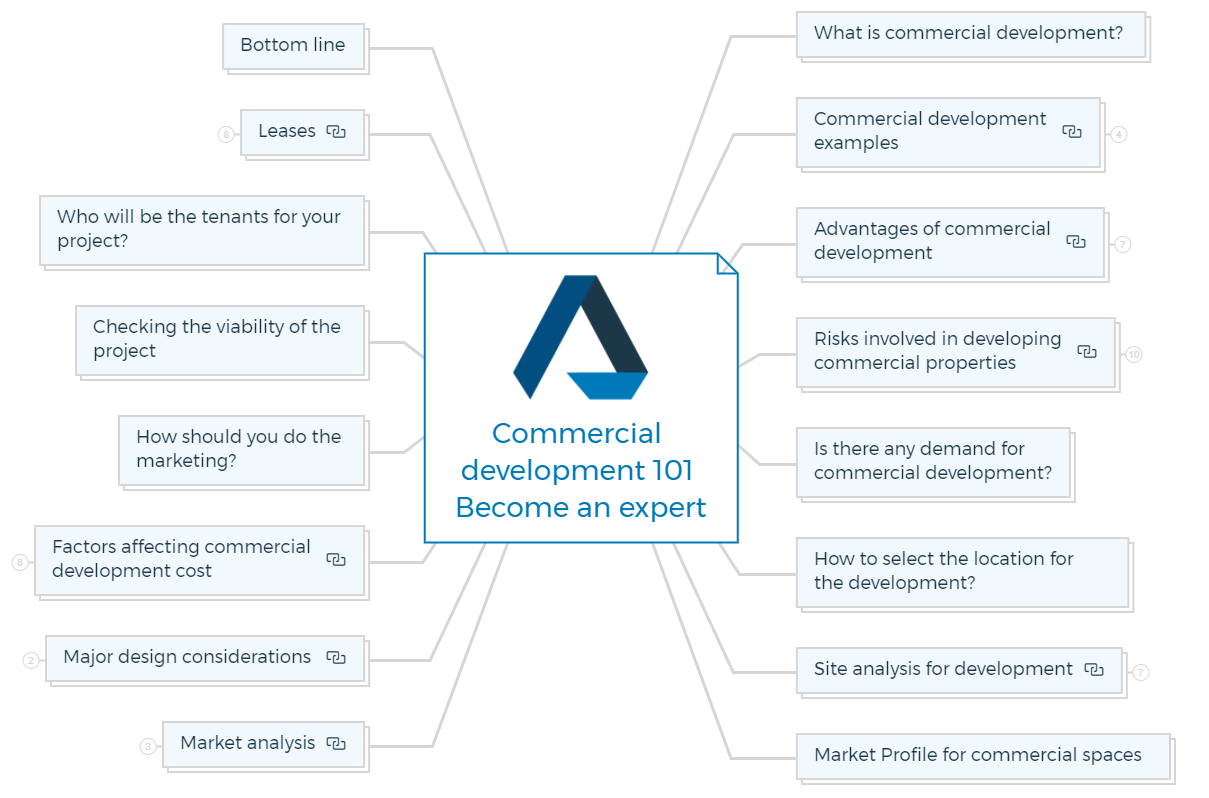
What is commercial development?
Commercial development generally refers to the process of developing land for commercial purposes, such as office buildings, retail stores, or factories. The term can also refer to the construction of new commercial buildings or the renovation of existing ones.
Commercial developers typically work with a variety of partners, including architects, engineers, contractors, and financiers, to get projects off the ground.
The commercial development process can be complex, and there are a number of different factors that need to be taken into account. For example, commercial developers need to obtain the necessary permits and approvals from local authorities before beginning any work.
They also need to make sure that their projects comply with all applicable zoning regulations. In addition, commercial developers need to be aware of the potential environmental impact of their projects and take steps to mitigate any negative effects.
Commercial development can have a significant impact on a community, and it is important for developers to consider the social and economic implications of their projects.
Commercial development examples
There are various varieties of commercial developments available. It may be for a one-person small business to a multi-disciplinary corporation and are classified as -

Renovated house
Renovated houses are residences in older areas that are remodeled and converted to professional offices due to zoning changes. Owner-occupiers, such as real estate agents, doctors, dentists, or smaller investors, typically develop these conversions.
Strata-title offices
These are smaller spaces within an office tower maintained by a body corporate. Strata title office buildings are typically built on the outskirts of the CBD.
Office parks
Office parks have grown in popularity over the last decade and are typically built in decentralised suburban regions where the property is less expensive. Smaller two-to three-story office structures are bordered by well-landscaped gardens and open areas in this development.
Office buildings with multiple stories
These are multi-storied office towers having high population density and good economic health. It also includes more extensive and intriguing office blocks, popularly known as skyscrapers.
Furthermore, such developments are assessed in the following manner:
- A grade - high-end finishes appropriate for a business tenant.
- B grade finishes range from medium to high in quality and are determined by their location.
- C grade finishes are typical and placed in less visible areas.
Advantages of commercial development
Below are the major advantages of commercial development over other real estate developments.
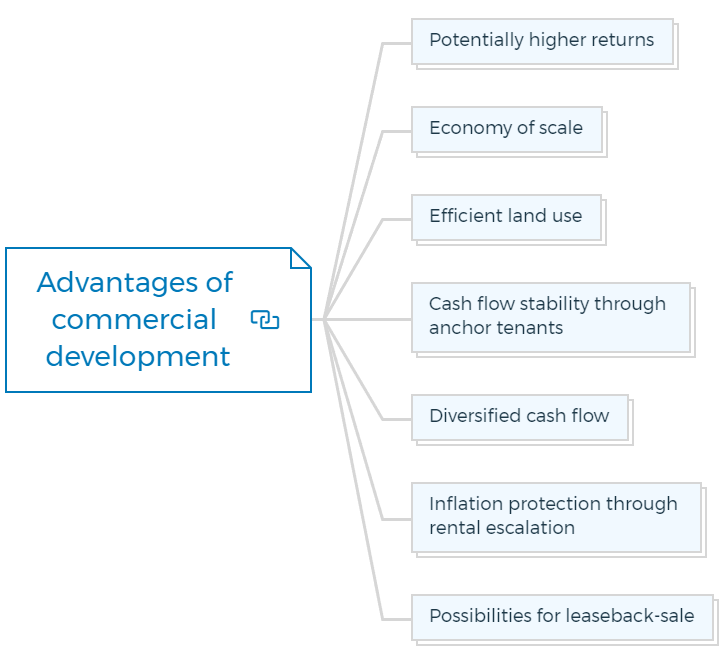
Potentially higher returns
Compared to residential expansions, commercial developments yield higher profits if built in the proper location. Property developers or investors get their returns by renting or selling the buildings at a rate per square meter for existing or proposed leases.
As a result, the construction or replacement cost has little value when contrasted to the location and rental agreements.
Economy of scale
Not much space is wasted in commercial developments if they are constructed appropriately, and you can also maximise the leasable area. External finishes and structural elements are all the same, allowing for economies of scale.
Efficient land use
To maximise their returns on inner-city office complexes, real estate developers build to the utmost permissible plot ratios. The planning of office parks and restored home offices, which are typically located on the city's outskirts, is more permissive.
Cash flow stability through anchor tenants
Securing a long-term tenant such as a 'blue chip' corporation or a government agency can give the investor or developer a steady income.
Diversified cash flow
Commercial developments can provide you with more options for lease negotiations. The developer may have to lower the asking rent to acquire a blue-chip tenant; but, you can make up the return from smaller tenants that want to be adjacent to the blue-chip corporation.
Inflation protection through rental escalation
There is a built-in annual rental increase in all contracts in commercial real estate developments. This escalation can be based on the consumer price index or an agreed-upon percentage. This means that the rental return does not lag or fall behind usual inflationary figures.
Possibilities for leaseback-sale
Some custom-built commercial buildings can be sold to a group of investors and then leased back for a set period. This frees up the company's financial reserves, which you can use for other aspects of the company's growth or development.
In other circumstances, speculative developers recruit high-profile tenants and then sell the property to cash-strapped investors.
Risks involved in developing commercial properties
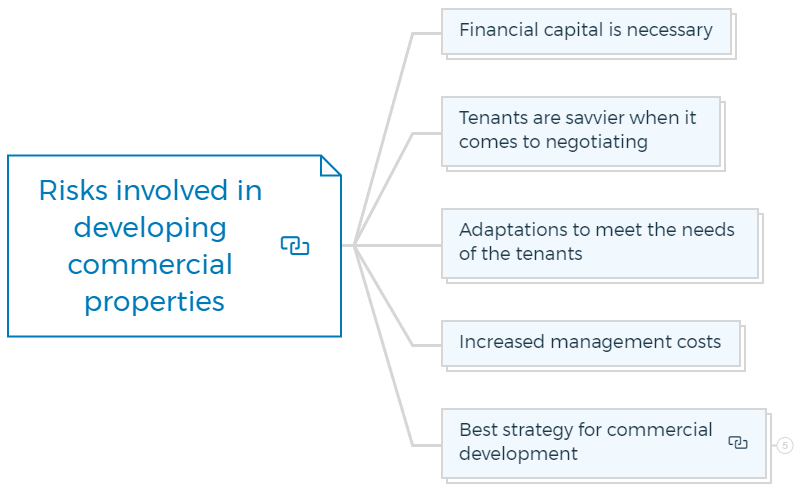
Financial capital is necessary
The building and land costs for developing commercial properties require a higher capital expenditure. Unless a well-located piece of land is purchased as residential and later rezoned to commercial, the land cost for such construction is often higher.
Tenants are savvier when it comes to negotiating
Most renters looking for commercial space are business people who approach lease negotiations with a business mindset. The developer and his agent or real estate broker should have strong negotiating skills.
Adaptations to meet the needs of the tenants
There may be a requirement to make various changes to acquire a tenant, which may not be suitable for future tenants. If you have to make these changes, make sure the tenant signs a long-term lease to recoup your investment.
Increased management costs
More significant office buildings will necessitate better administration and accounting systems. A full-time property manager may be necessary, depending on the size of the development, to ensure that the building runs smoothly.
Best strategy for commercial development
The best commercial development and investment strategy depends on the target market and whether the developer is interested in making a quick profit or long-term investment.
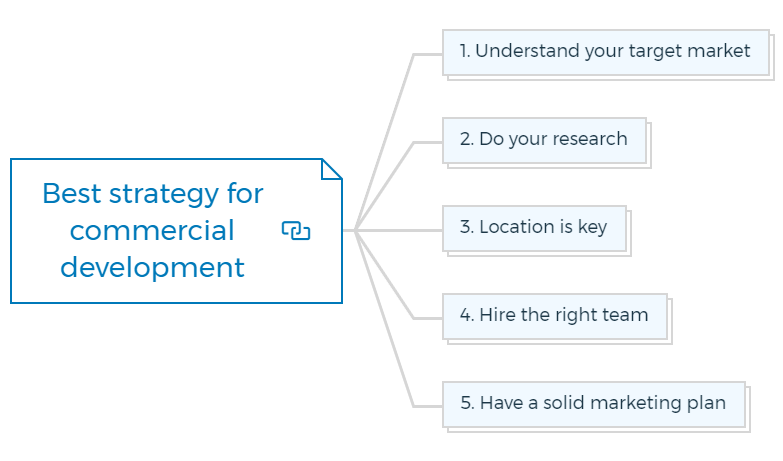
1. Understand your target market
When it comes to commercial development, you need to have a clear understanding of your target market. This includes understanding their needs and wants, as well as their buying habits. Only then can you develop a property that meets their needs and preferences.
2. Do your research
Before you start any commercial development project, you need to do your research. This includes understanding the market trends and the competition. Only then can you develop a property that will be in demand and generate good returns.
3. Location is key
When it comes to commercial development, location is key. You need to choose a site that is convenient for your target market and is in a desirable location. Only then can you expect your property to be successful.
4. Hire the right team
To ensure the success of your commercial development project, you need to hire the right team. This includes architects, engineers, and contractors who have experience in developing similar properties. Only then can you be sure that your property will be developed according to plan and within budget.
5. Have a solid marketing plan
Finally, you need to have a solid marketing plan in place. This includes understanding your target market and developing a strategy to reach them. This will help you to achieve the desired success in your real estate development journey.
Is there any demand for commercial development?
There is a high demand for commercial space especially among new businesses that are starting up and current tenants expanding their operations.
However, this demand is very cyclical and susceptible to supply and demand factors. Compared to residential space, commercial space is more responsive to these variations.
In a market with a shortage of commercial space, vacancy rates are lower. In contrast, vacancy rates are more significant in an oversupplied market, and the chances of sustained rental growth are very few.
In this post-covid world, the demand for commercial space is likely to be transformed. Space requirements will very certainly change in the new environment.
For example - Shared workspace, hot desks, 2 days office, 3 days home get adopted on a broader scale. Despite the shift in how we use the space, there is always a demand for new space; it remains an excellent cash-flow investment.
How to select the location for the development?
Research findings will heavily influence the location of the new commercial space. The study could show a shift away from high-rise CBD office buildings and toward office parks in suburban areas.
When purchasing a development site, you must consider the following aspects:
- Public transportation is available.
- Near complementary businesses
- Easy access to eateries and convention facilities
- Advertising exposure
Site analysis for development
The purpose of site analysis is to elicit all relevant information about the site, illustrating the benefits and limitations so that the development team may make informed decisions based on the current situation.
The team should consider the following items:
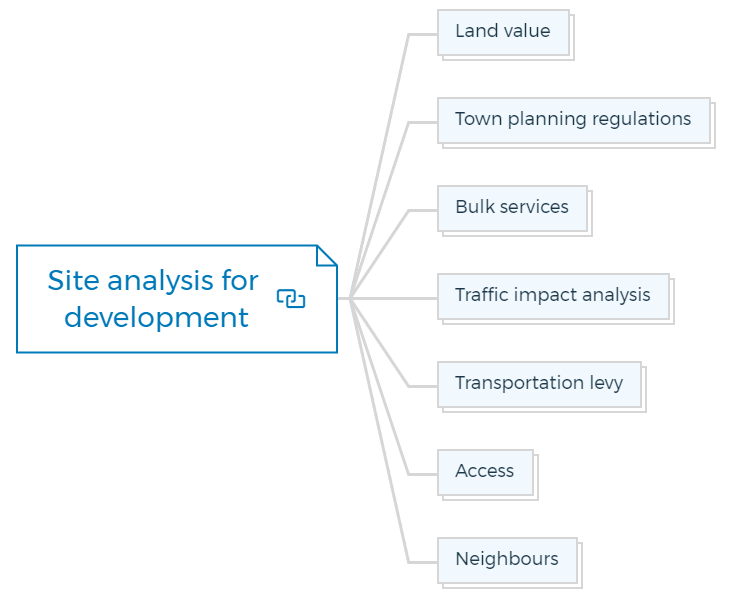
Land value
Is the asking price based on current market conditions, or has a residual value been determined? You should be aware of the crucial steps to calculate land value.
Town planning regulations
Is there a town planning report? How long must rezoning take place before construction can begin?
Bulk services
Are essential utilities such as water, electricity, and sewerage available in bulk? If not, how much would it cost to get them?
Traffic impact analysis
Has a traffic impact analysis been conducted, and how much did it cost the developer?
Transportation levy
Is a transportation levy required by the various states' primary road departments, and if so, how much does it cost?
Access
Is there convenient and well-located vehicular and pedestrian access?
Neighbours
What effect do the neighbouring structures have on the development? Are these two things compatible?
Market profile for commercial spaces
The market for new commercial space can be divided into several groups, including:
- Small enterprises run by one person
- Medium-sized companies
- Major firms
- Small government agencies
- Larger government offices
While one may assume an office tenant to be price-sensitive while looking for a place to rent, there are a few other things that a typical renter looks for in an office complex, including:
- Unique amenities
- Special services
- Prime location
Market analysis
Market analysis, including the following criteria, should be studied before a design brief or any significant financial commitment is made to commercial real estate development.
The developer must forecast employment figures in industries that use commercial space and the required amount when analysing the demand for new space.
The following are some crucial things to look for when measuring these variables.

Employment growth
This entails looking into and keeping track of:
- Economic factors at a national level, such as the gross national product
- The economic variables at the local level, such as the entrance of new industries and the expansion of existing industries
Changes in employment structure
- Changes in service-oriented industries
- The increase and decrease in government civil servant employment.
The utilisation of commercial space is evolving
- Thanks to modern office gear such as computers and photocopying machines, a reduction in spatial requirements and more efficient use of commercial space
- The impact of modern communication technologies, such as cell phones and the internet, decreases the need for travel.
Major design considerations
As previously said, office users range from a single business owner to a multinational corporation. As a result, unless a client has unique needs, there is no set planning formula to meet the varied users.
Furthermore, certain site constraints may compel the architect to create a structure that maximises the site's potential. A prominent example would be the design of a city office building, where the form and aesthetics take precedence above the needs of the tenants.
However, two essential elements in design are critical: flexibility and environmental considerations.

Flexibility
The development team can choose between an open plan or closed layout, or a combination of the two. All workstations should be easily reconfigurable to allow for the development of new groups and the inclusion or relocation of additional users.
The ultimate layout type will be entirely determined by the user's needs and the organisation.
Environmental considerations
Determining environmental requirements is an important planning step since it addresses what needs to be accomplished for the internal space to be a design success.
These are the needs, which are not design guidelines but design necessities:
- Technical acoustic systems must be adaptable to accommodate new layouts and densities
- Lighting levels must meet accepted criteria in all settings to handle traditional reading and writing duties
- To enable the rearrangement and addition of users, lighting throughout the interior must be adjustable.
- The fire and safety regulations must accommodate different users and planning patterns.
- Flexible power, telephone, computer networking, and electronic wiring should support various users.
- Users in various locations can easily use air conditioning and ventilation.
Factors affecting commercial development cost
Aside from the land and usual development costs, the following design elements might impact a project's overall cost and feasibility.
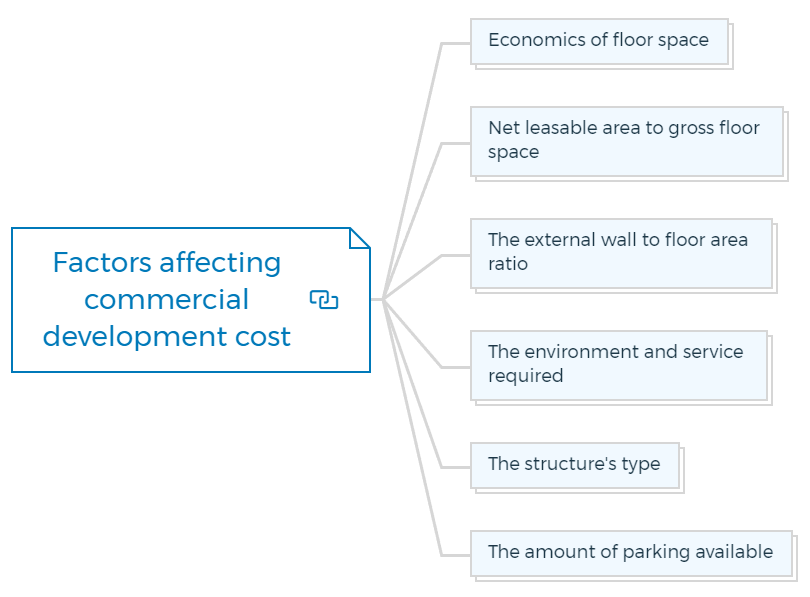
Economics of floor space
Developers who specialise in office buildings are well-versed in plot ratio calculations. The developer will hire an architect to design the structure using the maximum permissible construction size and extract the most leasable space possible.
Developers do not base the land cost for an office complex on the ground-floor area; instead, they analyse its genuine value relative to the permissible plot ratio.
Net leasable area to gross floor space
The connection between the gross and net leasable area in a plan is crucial. The development will be more profitable if the two figures are as close as possible.
The net-to-gross ratio varies from building to building and is determined not only by the architect's competence but also by the site and planning authorities' physical criteria.
The external wall to floor area ratio
The external perimeter wall is one of the most expensive components of any structure. The greater the distance between the external walls and the floor area, the more money saved on construction costs.
A square or rectangular building plan, for example, has less perimeter walling than an H-shaped plan with the same floor area. However, when attempting to improve the ratio, the designer must not raise the expense of artificial lighting.
The environment and service required
Artificial lighting and mechanical ventilation may have a high initial capital cost, not just in the short term but also over the structure's life. Aside from the constant maintenance, there is also the issue of energy waste, as artificial services are designed for multi-use rather than individual use.
Including as much natural light and ventilation as possible in the new building will help the developer and the environment.
The structure's type
The structure of an office building can significantly impact the project's overall economics and planning. When subterranean parking is required, this can be seen.
When land is expensive with limited space, structural features are typically constructed around cost-effective parking and traffic circulation.
The amount of parking available
The location of parking facilities is an essential aspect of office design and development economics. Its main effect is to limit the amount of floor space available and the structural grid arrangement.
Developers charge a fee based on a rate per bay because parking contributes considerably to the overall building cost.
How should you do the marketing?
The location, type of offices, and users targeted will determine the marketing of offices. Extensive finance, legal, and accounting businesses and significant corporations concentrate near the CBD to interact.
This includes government agencies, the stock exchange, the legal system, and the taxes office. Smaller businesses and professional practices tend to congregate towards the outskirts of the CBD.
These smaller enterprises don't necessarily need to daily interact with other businesses in the CBD.
Other essential characteristics that should be addressed in the marketing brochure and other marketing material, aside from the development's location, are:
- Its reachability
- The building's overall appearance from the outside
- The quality of the lobbies at the entrances
- The quality of carpets and partitions, as well as the allowance for them
- Availability of parking and nearby amenities
These considerations will all influence the tenant's decision based on their individual business needs and, more crucially, customer attraction.
Checking the viability of the project
The developer will conduct a feasibility analysis using cash-flow and residual value methodologies once they have developed an estimate of future revenues based on a research of demand for office building space.
The developer will have to account for expenses unique to buildings while doing this analysis. These can include things like:
- Services for cleaning
- Parking attendants and security
- A team of on-site engineers to look after the facilities and equipment.
Who will be the tenants for your project?
Securing blue-chip tenants is one of the most important aspects of a successful commercial development and investment: government agencies, banking institutions, and substantial international enterprises such as insurance companies.
Furthermore, securing a long-term lease would be a plus since it would ensure a consistent income, which would appeal to any investor.
If you're looking for smaller business renters, you'll need to look into their background, especially how long they've been in business. It is worthwhile to run credit checks on new firms through a credit bureau and, if necessary, run credit checks on the company's directors or owners.
Leases
Commercial leases are usually written in a standard style. Many well-known landlords and commercial real estate agents have their pre-printed documents with specific terms added as needed.
With larger corporate tenants, it's not uncommon for the developer to make concessions and create a new contract. The following are the most important terms and conditions negotiated between the developer and the tenant:
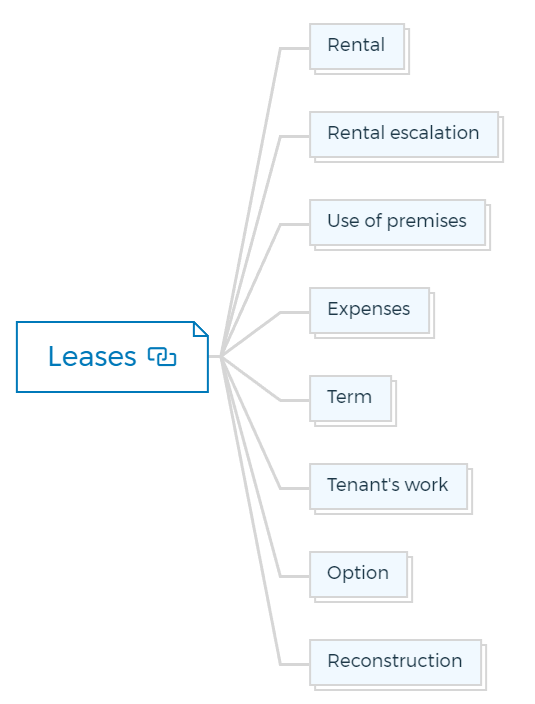
Rental
Try to get a rental that is both commercially viable and market-acceptable, as well as a payment deadline. Any late payments will be penalised.
Rental escalation
Could be a fixed percentage or a value based on the Consumer Price Index (CPI).
Use of premises
The sorts of businesses allowed in the building should be established.
Expenses
In most business leases, the tenant is responsible for the expenses. Rates, water, and power are all expenses.
Term
The lease should be for at least three years, but preferable for as long as possible.
Tenant's work
Any improvements made by the tenant during the lease should be approved by the landlord, and one should return the building to its original state at the end of the lease.
Option
This refers to adding in the lease a clause that allows you to extend the lease period or request additional space.
Reconstruction
The contract should include a condition allowing the landlord to rebuild and renovate the property.
Bottom line
Not everyone is a fan of residential development. An impatient developer will not enjoy dealing with unreasonable expectations and emotional outbursts from clients when the home is not built on time.
Now, you've got a clear idea on the question "what is commercial development". Small commercial development is a great place to start if you want to start developing and investing in a commercial area but don't want to commit to a large-scale project.
If you discover a larger office building, though, you don't have to go it alone; form a syndicate with a few friends or business acquaintances.
Enrol for the Quick-start property development course to quickly start your first development project successfully.
FAQs

